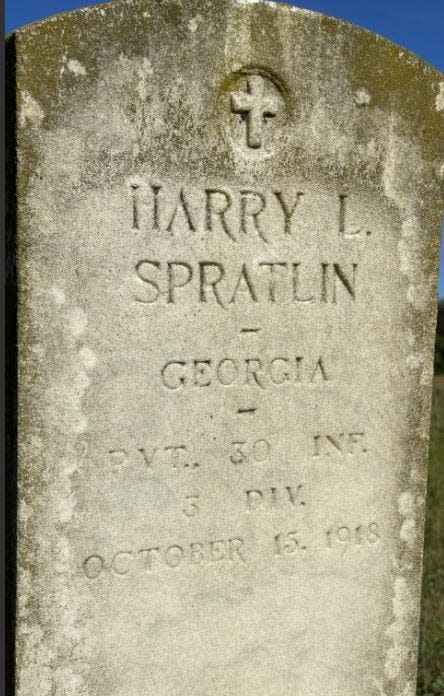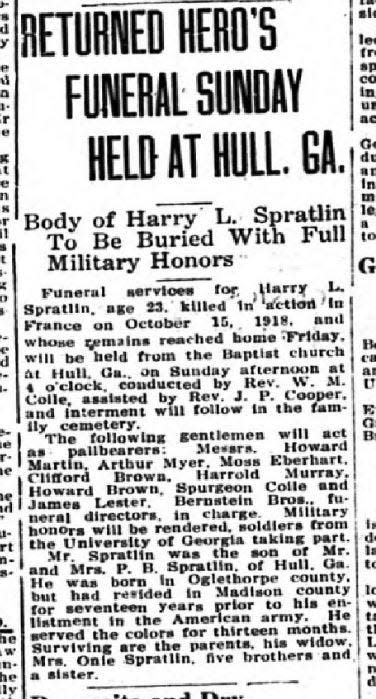Soldier from Hull who died in World War I no longer forgotten
A government-issue tombstone stands as a silent sentinel over Pvt. Harry L. Spratlin, a World War I soldier killed in action on Oct. 5, 1918, only weeks before the signing of the armistice that brought an end to the hostilities.
When his closest relatives and friends passed away, Spratlin was forgotten, leaving only the slab of marble in a tiny cemetery in a field in northeast Georgia.

Who was this young hero?
Public records have provided insights into the soldier's life, revealing a beloved husband, a cherished son, and a first-rate baseball player who kept his teammates laughing with his wit and humor.What follows are details pieced together after a month of research into military records, assorted government documents including Census documents, and century-old newspaper articles.
Harry Linton Spratlin was born on a farm in Oglethorpe County in 1895, the 10th of Pope and Lizzie Spratlin’s 11 children. The family moved a few years later to nearby Madison County. There, Spratlin received an education typical for the day, attending a small three-room schoolhouse through the seventh grade. After finishing school, he became a farmer, like his father and grandfathers before him, raising corn and cotton. And, like his father and grandfathers, he dreamed of one day raising a family of his own.
He had at least one other passion besides farming. It was baseball. He was the catcher on the Hull baseball team and scored one of the runs in a big opening-day win over rival Winterville in 1916.People enjoyed being around Spratlin because he kept them laughing. At the same time, he was described as a driven young man who always saw things through, no matter what. As one of his brothers once said: “I know his disposition. He’s not one to stand back from anything he had to do.”

Heading to war
In 1917, the United States entered the “Great War.” Spratlin received notice to report for induction into the Army in October with basic training to take place at Fort Gordon in Augusta. A few weeks before he was inducted, he married Leonie “Onie” Hardman. It was shortly before her 18th birthday. She would be a widow before she turned 19.
Spratlin had grown up attending Moore’s Grove Baptist Church where he was baptized before his deployment overseas. Whether he was saved during the church's August revival or as a result of military camp ministries is not certain. But in a reflection of Harry’s faith, a chaplain had written Onie some time before his death describing her husband’s habit to read "from his Army New Testament every day.”
His mother especially expressed great comfort in the fact that he had made peace with God before leaving for war.
Army educator: Retired Army officer, picked as next president of University of North Georgia
Wildlife art: Athens students nab top spots in statewide wildlife poster contest
The 3rd Division began arriving in France in the late spring and almost immediately went into action during the Second Battle of the Marne. Spratlin's company fought near the village of Jaulgonne. This battle was the last major German push of the war, and the 3rd Division successfully stopped repeated enemy assaults, earning the nickname “The Rock of the Marne.”
Most of the combat in WWI was trench warfare. Armies dug trenches hundreds of miles long. Opposing armies were separated by a stretch of terrain called “no man’s land.” Artillery attempted to weaken the opposing line before infantry left the trenches, described as going “over the top,” racing towards the opposing lines and hoping to break through. In a letter home to Onie, possibly trying to ease her fears, Harry wrote, “I’ve been over the top, it’s not so bad once you get going.”
It was far worse than bad. Soldiers were in the open and exposed, subjected to enemy fire or mustard gas attacks as they crossed "No Man's Land." If one managed to make it to the enemy lines, it was hand-to-hand combat, providing the enemy had not already retreated further back into another line of pre-prepared trenches.
In the fall of 1918, the 3rd Division found itself again in the midst of a raging battle in the Argonne Forrest. This was the battle that drove the Germans to end the war. It’s impossible to know what was going through Harry’s mind as he was engaged in battle.
What is known is that Spratlin was killed in action near the small French village of Cunel on Oct. 15, 1918. He was buried nearby in a large American military cemetery.

Finding closure
Less than a month later, the armistice was signed, ending the war. The following week, Onie received a telegram with the message that her husband had been killed.
The cemetery in France would not be his final earthly resting place. Several years after the war, the U.S. government gave families the option of bringing the remains of their loved ones home, not only to bring the families comfort and closure but as a tangible reminder to their home communities of the sacrifices they had made in service to their country. Onie was one of more than 40,000 who chose to have their loved ones’ remains returned.
The U.S. Army transport ship Wheaton, carrying nearly 5,000 caskets was the first to return in 1921. One of those caskets held Harry's remains. After the ship arrived in New Jersey, a large memorial service was held. President Warren G. Harding at the service pledged, “We shall not forget, no matter whether they lie amid the sweetness and bloom of the homeland or sleep in the soil they crimsoned.”
The casket arrived by train at the depot in Hull on Sept. 23, 1921. It was carried a few blocks from the depot to the Moore’s Grove Baptist Church where memorial services were held on Sunday Sept. 25. They were conducted by two of his boyhood pastors and included full military honors. The University of Georgia Cadet Corps provided the military honor guard. One of his nieces, just a child at the time, later remembered how moving the service had been.
His remains were taken from the church on a final 1-mile journey to the cemetery where his tombstone still stands. It is a reminder of a hero, who like many others may have been forgotten in time.
Through the years, those who remembered Harry passed away. Fewer people came to place flowers on the tombstones. His widow, Onie, moved to another state a few years later. It would be 15 years before she remarried but never had any children. In time, there was no one to pass the memory along.
Oddly, Spratlin’s name does not appear on any memorials or lists of those killed in action from Clarke, Madison or Oglethorpe counties of Georgia. His memory and his sacrifice had been forgotten.Unfortunately, Spratlin isn't alone in being forgotten. The same thing has happened to countless heroes across the country.
The Bible, in a reference to those who serve in the government, implores “to give honor to whom honor is due.” This Memorial Day, maybe these few words can help the family, church and a larger community recall, remember, and honor for a moment the sacrifice of a forgotten hero and others like Private Harry L. Spratlin.
Charles G. Jones is a Baptist minister, a historian, and a freelance writer who lives in Bogart. Jones happened upon Spratlin's headstone recently while visiting a cemetery and was inspired to research his story.
This article originally appeared on Athens Banner-Herald: World War I soldier from Hull became a forgotten warrior
